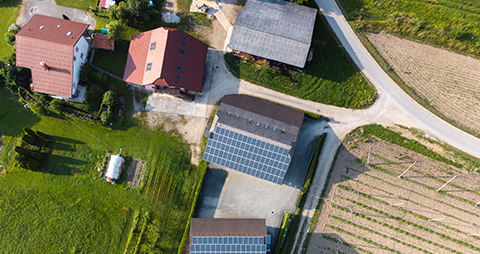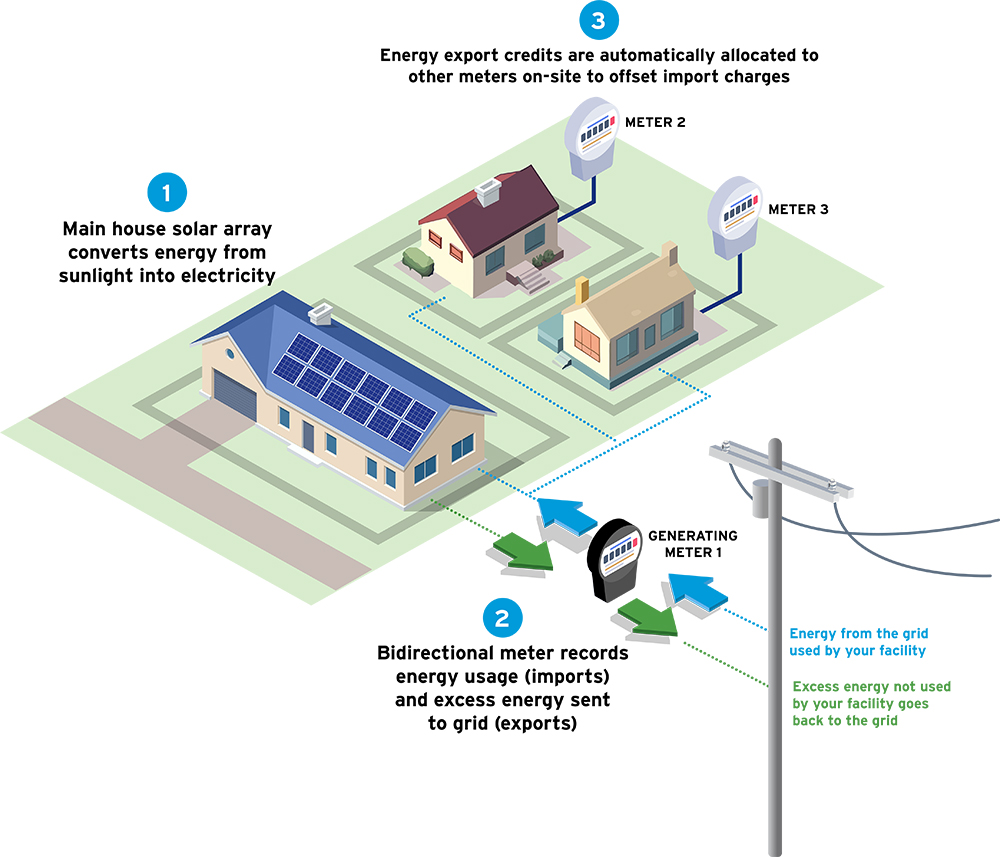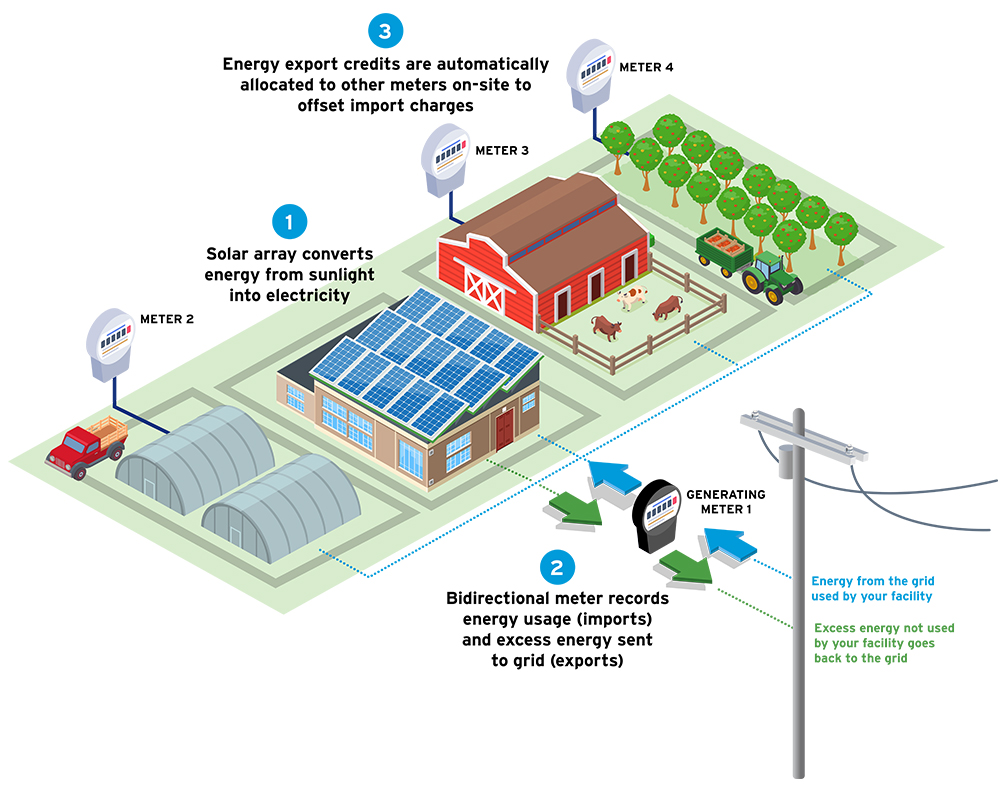Solar Billing Plan Aggregation (SBPA)
Solar-Powered Properties
Lower Carbon Footprint, Lower Energy Bills

How Solar Billing Plan Aggregation works
Solar Billing Plan Aggregation allows customers that have a renewable energy system, like solar panels, combine the energy usage from multiple electric meters on the same or adjacent properties. With aggregation, the electricity generated by the solar panels can offset the electricity usage across all electric meters, not just the meter connected to the solar panels.
Aggregation customers can range from homeowners with small residential properties to business owners with large commercial properties.
Here are two examples of Solar Billing Plan Aggregation:
Residential
In this example, the residential customer has a main house with solar panels and two guesthouses on their property. Each home has its own separate electric meter.
The main house with solar is tied to Generating Meter 1. This meter is recording all the energy usage (imports) and excess energy sent to the grid (exports) for the entire property.
The export credits generated from the solar system are distributed to the different meters on the property to offset import charges.
Every month, SDGE automatically adjusts the portion of credits each meter receives based on its usage. This ensures that all meters receive the most effective distribution of credits.

Commercial
In this example, the commercial customer has an industrial building with solar panels, two greenhouses, a barn and an orchard on their farm. Each area on the farm has its own separate electric meter.
The industrial building with solar is tied to Generating Meter 1. This meter is recording all the energy usage (imports) and excess energy sent to the grid (exports) for the entire farm.
The export credits generated from the solar system are distributed to the different meters on the farm to offset import charges.
Every month, SDGE automatically adjusts the portion of credits each meter receives based on its usage. This ensures that all meters receive the most effective distribution of credits.

Solar Billing Plan Aggregation (SBPA) FAQs
Your account is transitioning to Solar Billing Plan Aggregation because your solar system has reached the end of its 9-year Net Energy Metering Aggregation legacy period. Note: If you recently moved into a property that has solar, the NEM Aggregation legacy period began when the solar panels were initially installed and interconnected.
Solar Billing Plan Aggregation customers will have one generating account and one or more benefiting accounts.
- A generating account is for the electric meter that is directly attached to the solar system. For example, a generating account could be for the meter for a building that is connected to solar panels.
- A benefitting account is one or more accounts that receive a portion of the export credits from the shared solar system. For example, a benefitting account could be for the meter for an on-site guesthouse that benefits from the solar energy produced.
Generation and Delivery Import Charges are summed for a total charge amount and Generation and Delivery Export Credits are summed for a total credit amount. These dollar amounts are then netted at time of billing.
Export credits are split into two separate buckets: Generation Export Credits and Delivery Export Credits. Generation Export Credits can only be used to offset Generation Import Charges, while Delivery Export Credits can only be used to offset Delivery Import Charges.
Yes, with Solar Billing Plan Aggregation, customers are incentivized to generate electricity from their solar system and store it in a battery so they can use it during on-peak evening hours from 4 p.m. to 9 p.m. when electricity is priced the highest. This can reduce the amount of electricity you use from the grid, which helps maximize your savings.
As a Solar Billing Plan Aggregation customer, your bill is due monthly.
Residential customers will take service on Time-of-Use (TOU) pricing plan EVTOU5. Commercial customers may take service on any eligible pricing plan.
As a Solar Billing Plan Aggregation customer, you receive a monthly bill along with an annual true-up bill at the end of each 12-month period. If you exported more than you imported throughout your entire true-up period, your true-up bill will reflect an Annual True-Up Adjustment charge or credit.
The True-up Adjustment accounts for changes in export pricing that happen throughout the year. If you imported more than you exported during the 12-month period, no adjustment is necessary, and this amount will be zero.After you receive your true-up bill, your account is automatically reset for a new 12-month period. Any Generation or Delivery Export Credits remaining at the time of true-up, will carry over indefinitely until the credits are used or until you end service.
Customers with paired battery storage are eligible to be compensated for exports up to a set amount each month based on system size and climate zone. For customers with a 10kW battery size or less, credits will be capped if the credits reach the set amount in each bill period. For batteries greater than 10 kW with a Net Generation Output Meter, capping is determined based on each interval in the bill period.
If you would like to end Net Energy Metering Aggregation (NEMA) or Solar Billing Plan Aggregation (SBPA) but retain solar at your home or business, you will be switched to the regular Solar Billing Plan. Since the sunset period has passed for NEM 1.0 and 2.0 programs, customers are no longer able to switch to these programs.
If you are planning to remove the solar system entirely, you will be eligible for standard non-solar residential or commercial pricing plan options. In either case, you will need to notify SDGE Customer Generation of your intent to terminate your participation in the aggregation program.
No. DR-SES is limited to single meter residential customers with a solar energy system.
Yes, if all eligibility requirements are met.